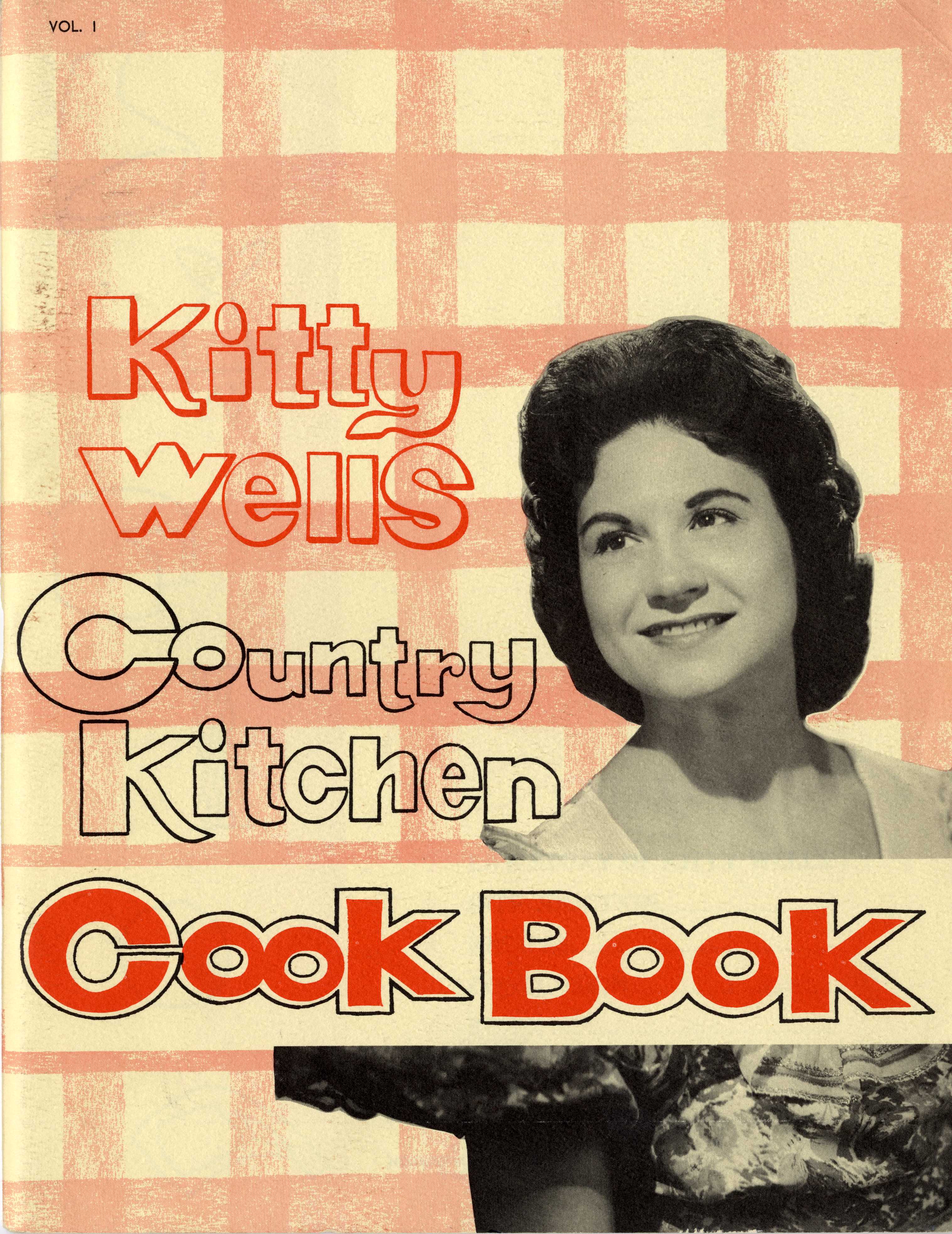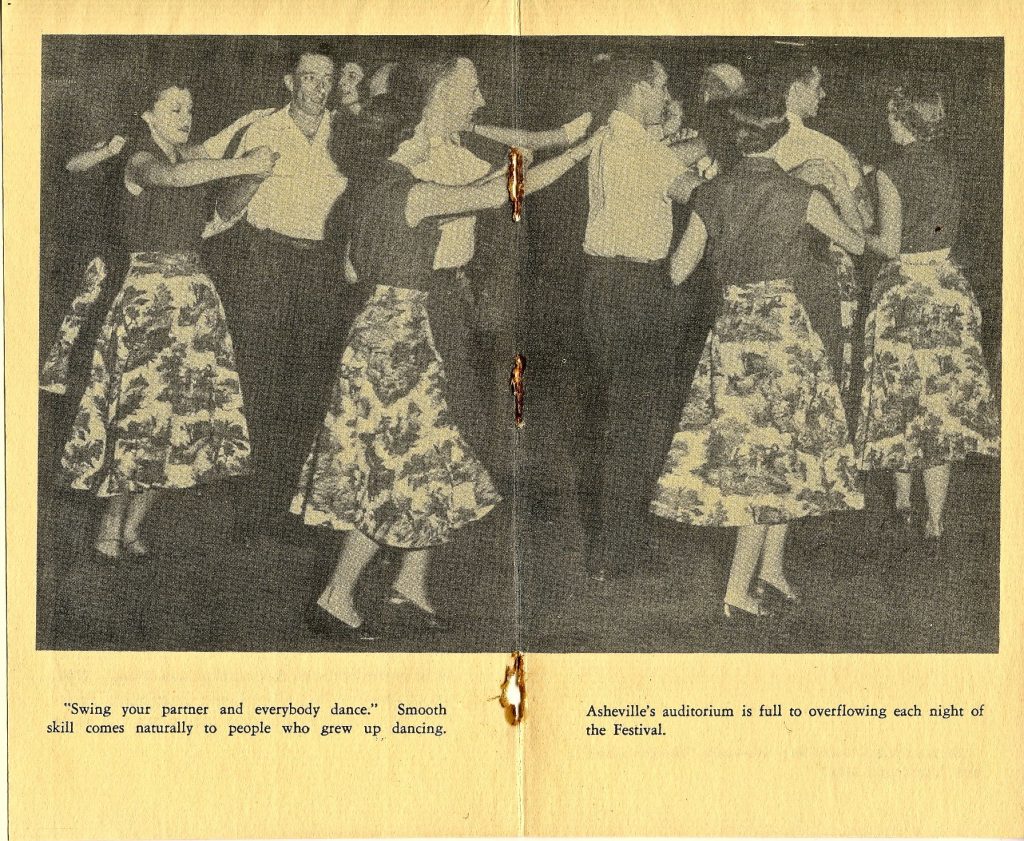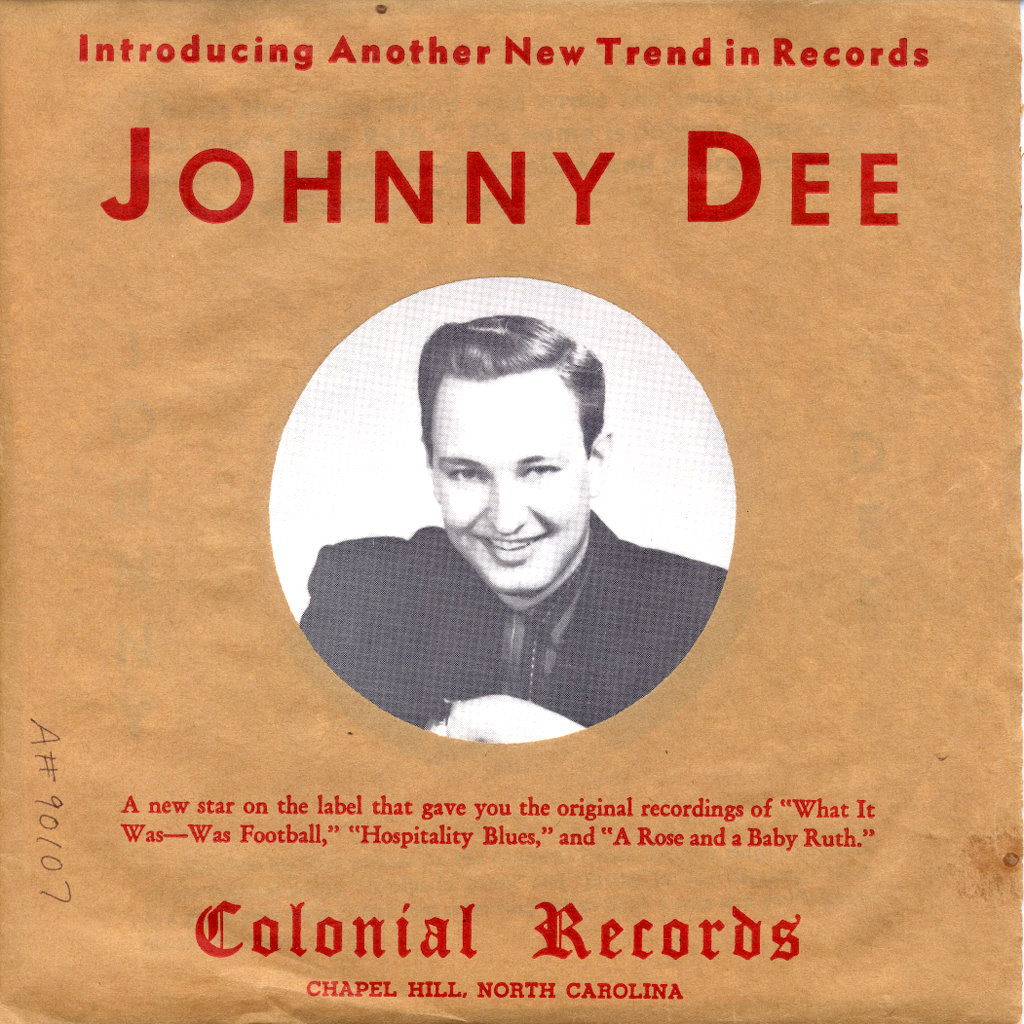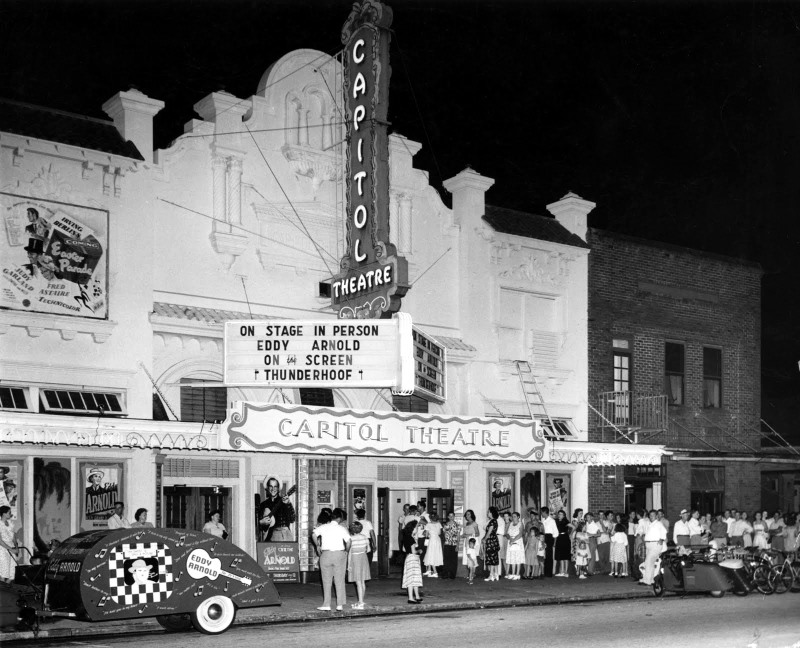 As promised, a few more holiday treats for the snack table. These come courtesy of the Kitty Wells Cook Book, vol. 1 (1964), from NF2158 in the Southern Folklife Collection Artist Name Files (#30005). Start off the night with a “Pink Quickie,” before enjoying a delicious “Cranberry Christmas Mold” and some “Holiday Fruit Cookies.” A party menu like no other! Perfect for shooting pool with good friends, like Kitty Wells husband, Johnny Wright (pictured below). Come back tomorrow for some more Southern Folklife Collection holiday finds.
As promised, a few more holiday treats for the snack table. These come courtesy of the Kitty Wells Cook Book, vol. 1 (1964), from NF2158 in the Southern Folklife Collection Artist Name Files (#30005). Start off the night with a “Pink Quickie,” before enjoying a delicious “Cranberry Christmas Mold” and some “Holiday Fruit Cookies.” A party menu like no other! Perfect for shooting pool with good friends, like Kitty Wells husband, Johnny Wright (pictured below). Come back tomorrow for some more Southern Folklife Collection holiday finds.
Tag: Southern Folklife Collection
SFC Spotlight: Mountain Dance and Folk Festival, 1955

As the days continue to get shorter and we rarely emerge from the Southern Folklife Collection in time to catch the last light of the day, we welcome a ray of sunshine like this 1955 Asheville Chamber of Commerce informational pamphlet about Bascom Lamar Lunsford and the Mountain Dance and Folk Festival from Folder 368 in the Artus Moser Papers (collection #20005). The map on the inside cover is fantastic (click to enlarge).
 Ballad collector, educator, and historian Artus Monroe Moser was born 14 September 1894 in Hickory, N.C., to David Lafayette (Fayette) Moser and Cordelia Elizabeth King Moser. When Artus was two, the family moved to Buckeye Cove, N.C., located in Buncombe County near the Swannanoa Valley, where his mother had grown up and her family still lived. In 1904, Fayette Moser took a job as forester for the Biltmore Estate and moved the family there, where they remained until 1917 when Fayette became the North Carolina State Forest Warden on Mt. Mitchell. The family spent twelve years on Mt. Mitchell, then returned to Swannanoa after Fayette was hired as Warden for the Beacon Blanket Mill watershed.
Ballad collector, educator, and historian Artus Monroe Moser was born 14 September 1894 in Hickory, N.C., to David Lafayette (Fayette) Moser and Cordelia Elizabeth King Moser. When Artus was two, the family moved to Buckeye Cove, N.C., located in Buncombe County near the Swannanoa Valley, where his mother had grown up and her family still lived. In 1904, Fayette Moser took a job as forester for the Biltmore Estate and moved the family there, where they remained until 1917 when Fayette became the North Carolina State Forest Warden on Mt. Mitchell. The family spent twelve years on Mt. Mitchell, then returned to Swannanoa after Fayette was hired as Warden for the Beacon Blanket Mill watershed.
Growing up in the mountains of Western North Carolina instilled in Artus a deep respect for the traditions of Appalachia, which continued to influence him throughout his life. University of North Carolina in Chapel Hill, where he studied under historian R. D. W. Connor and received his A.B degree in 1923. During his time in Chapel Hill, Moser began to develop his lifelong interest in North Carolina history and folklore. After serving as principal of Swannanoa High School for two years, he returned to Chapel Hill to pursue an M.A. degree, which he received in 1926. During this time, he also worked as a research assistant under Howard W. Odum in the Institute for Research in Social Science. In the years after leaving Chapel Hill, Artus pursued further graduate work at the University of Wisconsin, Madison, and studied painting at the Pennsylvania Academy of Fine Arts, the Chicago Art Institute, and the Grand Central Art School in New York City. He worked as a professor of English and speech at the University of Tennessee at Knoxville before moving back to the Swannanoa area in 1943, where Artus taught in various schools until his retirement in 1964.
Artus began to collect ballads and folktales during his years in Tennessee, where he had encouraged his students to investigate their own heritage. He also contributed ballads to the collection of University of Tennessee folklorist Edwin C. Kirkland. Back in North Carolina, Artus avidly collected ballads and folktales in and around the western part of the state, recording local singer and storyteller Maud Gentry Long and musicians Jean Ritchie, Bascom Lamar Lunsford, and Pleaz Mobley, among others.
 Moser also collected biographical information about prominent Western North Carolinians, including some of the folklorists and ballad singers he recorded. The folder on Bascom Lamar Lunsford, Folder 368, contains information about him as well as about the Mountain Dance and Folk Festival he founded in 1927 in Asheville, N.C. Included it this pamphlet (click images to enlarge). We especially like the contact information for Mr. Lunsford on the final page, “Bascom Lamar Lunsford can be reached at his home, South Turkey Creek, Leicester, N. C., ten miles north of Asheville.”
Moser also collected biographical information about prominent Western North Carolinians, including some of the folklorists and ballad singers he recorded. The folder on Bascom Lamar Lunsford, Folder 368, contains information about him as well as about the Mountain Dance and Folk Festival he founded in 1927 in Asheville, N.C. Included it this pamphlet (click images to enlarge). We especially like the contact information for Mr. Lunsford on the final page, “Bascom Lamar Lunsford can be reached at his home, South Turkey Creek, Leicester, N. C., ten miles north of Asheville.”
See one last image below or visit us in Wilson Library and view the whole thing in our reading room. Don’t forget tickets are available for the second event in the Southern Folklife Collection Instrument Series celebrating the fiddle, Friday and Saturday, January 11-12 at UNC. The Friday concert in Memorial Hall features Nashville Bluegrass Band, Byron Berline, Matt Glaser and Bobby Taylor. The Saturday symposium in Wilson Library includes lectures and performances on American Fiddle Styles with Byron Berline, Matt Glaser Bobby Taylor, Paul F. Wells and Mark Wilson. Events are free and open to the public, but concert tickets are required for Friday night and available at Memorial Hall Box Office: 919.843.3333. 
Thursday 10": Leadbelly*
 * the album title is “Leadbelly,” however, Mr. Ledbetter himself spelled his name as two words, “Lead Belly”
* the album title is “Leadbelly,” however, Mr. Ledbetter himself spelled his name as two words, “Lead Belly”
Earlier this week, we had the good fortune of revisiting this remarkable Huddie Ledbetter 10″ LP from the Capitol Records “Classics in Jazz” series, Southern Folklife Collection call number FC14651. Issued in 1953, almost four years after Lead Belly’s death, the album is remarkable not only because of the striking portrait of Ledbetter and his famous 12-string guitar, but also because of Ledbetter’s accompaniment on the recordings. In the liner notes, Paul Mason Howard is credited with playing the zither on “these historic performances.” The interplay of zither with Ledbetter’s booming 12 string is highly enjoyable and these recordings (made in California in 1944) showcase Ledbetter in top form. Listen to the intro to “Back Water Blues” from side 2:BackWaterBlues_Leadbelly_FC14651_Southern Folklife Collection
Mr. Howard, a pianist and composer who worked in vaudeville and collaborated with Tin Man and Beverly Hillbilly, Buddy Ebsen, before working extensively as a songwriter for the Walt Disney Company, is actually playing the Dolceola. Mr. Howard supplemented his songwriting career performing on hybrid string instruments like the Dolceola and Cithare. These recordings of Lead Belly and Howard are likely the first commercial recordings of the Dolceola. The solo on the duo’s recording of “Ella Speed” highlights the unique tone of the Dolceola:EllaSpeed_Leadbelly_FC14651_Southern Folklife Collection
It was once thought that legendary Texas gospel singer Washington Phillips performed on the Dolceola, but his instruments were later confirmed to be two Celestaphones, More on Phillips and the Celestaphone another time, but for now we leave you with the final track from the LP, Lead Belly’s arrangement of the classic cowboy tune “Western Plain”. To recap, this is a recording of a performer identified as a blues musician, playing a cowboy song, released on a jazz record…. as another classic cowboy song says “Don’t fence me in.” Come a cow-cow yicky. come a cow-cow yicky, yicky yea.WesternPlain_LeadBelly_FC14651_Southern Folklife Collection
SFC Spotlight: Barbara Allen, the Song Without a Single Tune

As one of the most oft-played folk ballads in the Western tradition, the commonly titled “Barbara Allen” has spawned so many variations it’s nearly impossible to identify a primary tune. Reaching the height of its popularity during the 17th and 18th centuries in the British Isles and America, the ballad has been sung in parlors and on front porches for hundreds of years. It has branched into countless forms, known variously as “Barbary Allan,” “John Armstrong’s Last Good-night,” and “The Cruelty of Barbara Allen,” among many others (Source: Francis Child’s English and Scottish Ballads ).
Charles Seeger, the renowned American musicologist (1886 –1979), visited these parlors, collecting field recordings from all over the country on a quest to locate the definitive “Barbara Allen” tune. Drawing samplings from North Carolina to Michigan to California, he selected 30 renditions to study, 15 sung by women and 15 by men. The Southern Folklife Collection houses his compilation of the recordings on the Versions and Variants of Barbara Allen , accompanied with a detailed draft brochure.
After listening to the recordings and categorizing them according to musical mode into versions and variants, Seeger concludes that “no such entity as ‘the Barbara Allen tune’ can be set up…, however, two versions have such distinct characters.” The first version sounds completely unlike any of today’s more popular recordings of the ballad because of its archaic melody. Seeger states, “Version I in the AAFS seems to bear no relationship to conventional major or minor modality and the concept of tonality.” Here is a recording of a middle-aged man singing a variant of Version Ia “Barbara Allen”:
Barbara Allen Sample 1
In contrast, the second version sounds much more pleasing to the ear because “Version II will seem…closely related to our conventional major mode.” Here is a recording of an older woman singing Version IIa:
Barbara Allen Sample 2
The lyrics of this ballad tell the haunting story of Barbara Allen’s cold rejection of a dying man’s love, and her regrets as she hears the death bell toll. Realizing her mistake, she chooses death also and is buried next to her unrequited lover. Two examples of the opening verse of the ballad include:
The red buds they were swelling
Sweet William upon his dead bed a lie
For the sake of Barbry Allen
When all the flowers were a blooming
Sweet William on his death bed lay
For the love of Barbara Allen
While the lyrics vary from recording to recording, all versions share the same central plot. But, because the story’s spirit changes as the tune evolves, listening to the 30 variants remains captivating. The differences between minor and major modes, quick or dragging tempos, and the color of each singer’s voice uncover multiple levels and moods of Barbara Allen’s tragic story. One man sings the ballad like a cautionary tale to young lovers; another woman sings as if she were Barbara Allen herself, mourning a personal experience. In this way, Charles Seeger’s Versions and Variations of Barbara Allen celebrates how a ballad is neither singular nor static but a living history of time and place.
Photo of the Week: Bascom Lamar Lunsford

It is hard to pick a favorite from the remarkable portraits of Bascom Lamar Lunsford from the John Edwards Memorial Foundation Records (#20001), but I always come back to this one, call no. P1651. See this photo and many others in our upcoming exhibit, The Banjo: Southern Roots, American Branches.
Please join us first for the banjo symposium Saturday, August 25 from 10am to 4pm in the Pleasants Family Assembly Room, Wilson Special Collections Library, UNC-CH, followed by a free concert in UNC’s Memorial Hall including master pickers Tony Trischka,Dom Flemons of the Carolina Chocolate Drops, and Riley Baugus with Kirk Sutphin. This is a free but ticketed event. Tickets are now available at the Memorial Hall Box Office, 919.843.3333.
SFC Photo of the Week: Mike Seeger and Elizabeth Cotten
 Another image from the Mike from the Mike Seeger Collection, this time playing guitar with his dear friend, Chapel Hill’s beloved Libba Cotten, in 1978 or 1979.
Another image from the Mike from the Mike Seeger Collection, this time playing guitar with his dear friend, Chapel Hill’s beloved Libba Cotten, in 1978 or 1979.
Join us tonight, March 23, 2012, in Wilson Library on UNC’s campus for a discussion and concert in celebration of the life and work of musician, documentarian, and scholar Mike Seeger.
SFC Spotlight: Curating Sound and Seven Inch Records

On Thursday October 20, 2011, the UNC Music Library will celebrate its seventy-fifth anniversary with the opening of an exhibition in the Melba Remig Saltarelli Room on the third floor of the Louis Round Wilson Special Collections Library. The exhibition, entitled “Curating Sound: 75 Years of Music Collections at UNC” will feature materials from the Music Library, the Southern Folklife Collection, and the Southern Historical Collection of the University Library. On display will be items as diverse as Palestrina prints, libretti from the Florentine Camerata, Lully manuscripts, historic sound recordings, rare concert posters, and even Andy Griffith’s guitar.
The exhibition will open with a reception at 5 pm, a keynote address by Prof. Tim Carter, the David G. Frey Distinguished Professor of Music, and a short concert featuring works from the collection, including ensembles performing English baroque, Old-time stringband, early rockabilly, and Irish traditional music.
While looking for items to contribute from the Southern Folklife Collection, these two 7-inch 45 rpm records (above and below) caught our eye and seemed worthy of further exploration. Above is the cover to Chants au pied de l’Annapurna [Chants at the foot of Annapurna], field recordings from central Nepal by Rene de Milleville–a french writer who lived in Nepal, specializing in the study of rhododendrons and orchids of the region. The following is a sample of the track “Sitarané” from side A.
“Sitarané” performed by musicians from central Nepal Sitarane`
From closer to home in the John D. Loudermilk Collection (#20148), we found a 45 rpm record from Chapel Hill’s own Colonial Records, owned and operated by Orville B. Campbell. Johnny Dee, the first recording moniker of country great John D. Loudermilk, was a student at Campbell College when he recorded “A-plus In Love.” featuring Joe Tanner on the guitar. North Carolina Collection Photographic Archives blog, A View To Hugh, has an excellent article on Loudermilk, and for a few more tracks see this Field Trip South post from two years ago. More information and updates on the exhibit to come, but for now, enjoy a little Johnny Dee.
“A-Plus In Love” by Johnny Dee A-Plus In Love_Johnny Dee

SFC Spotlight: Back to school with Jimmy Boyd and the School for Workers
78-5076. Jimmy Boyd, “(I’ve got those “wake up, seven-thirty – wash your ears they’re dirty – eat your eggs & oatmeal – rush to school”) blues”[audio:https://blogs.lib.unc.edu/sfc/wp-content/uploads/sites/9/2011/08/78-5076_1.mp3|titles=78 5076_1_Jimmy Boyd]
School is back in session here at UNC, and we are more happy about that than the incomparable Jimmy Boyd (probably best known as the amazing voice of “I Saw Mommy Kissing Santa Claus”). Boyd recorded this tune in 1953, one of a number of popular country and novelty tunes he recorded for Columbia throughout the 1950s, including duets with Rosemary Clooney and Frankie Laine. While some of the novelty tunes have not aged terribly well, this track is country pop candy with the Norman Luboff Choir and pedal steel likely performed by the equally incomparable Speedy West.
Steel solo, 78-5076. Jimmy Boyd, “(I’ve got those “wake up, seven-thirty – wash your ears they’re dirty – eat your eggs & oatmeal – rush to school”) blues”[audio:https://blogs.lib.unc.edu/sfc/wp-content/uploads/sites/9/2011/08/78-5076_2.mp3|titles=78 5076_2]
We have an exciting fall of projects and programs ahead. “From the Cradle to the Cave,” our exhibit of North Carolina poster art from the SFC collections opened last week in Davis Library and will hang until next may. It was an excellent event with all five artists present and sweet sounds courtesy of The Kingsbury Manx.
Tickets are on sale for our concert tribute to Howlin’ Wolf. Scheduled for September 19 in the Great Hall of the UNC Student Union, the concert will feature Alvin Youngblood Hart, Eddie Shaw and the Wolf Gang, Jody Williams, and Henry Gray. Prior to the concert, a free public symposium will take place in Wilson Library. At 5:30 p.m., blues scholar Peter Guralnick will discuss Howlin’ Wolf’s life and music. Guralnick is currently writing a book about Sam Phillips, the Sun Records founder who discovered not only Howlin’ Wolf, but also Elvis Presley, Jerry Lee Lewis, and Johnny Cash.
Guralnick will then be joined for a Q&A conversation with Phillips’s son Knox Phillips, who learned the music business from his father before embarking on his own career as an engineer, producer, and studio owner. The concert is the first in a series of blues tributes hosted by the Southern Folklife Collection in 2011 and 2012.
 In honor of the first Monday of the school year, we wanted to share some items to inspire the coming work ahead. What better inspiration than Labor Songs for All Occasions, produced by The School for Workers at the University of Wisconsin in 1940. Part of the SFC Song Folios Collection #30006, circa 1882-1983, call no. FL-409.
In honor of the first Monday of the school year, we wanted to share some items to inspire the coming work ahead. What better inspiration than Labor Songs for All Occasions, produced by The School for Workers at the University of Wisconsin in 1940. Part of the SFC Song Folios Collection #30006, circa 1882-1983, call no. FL-409. 
There are songs for all occasions, “March of the Toilers,” for walking to classes, “Soup Song” for trips to Lenoir, “Put on Your Smart Now Bonnet” for homework and test preparation, and “We’ll Not Be Fools” as and “The Cudgel Song” for mid-term exams and finals. Choose your favorite from the the contents below.

Photo and Folio of the Week: Eddy Arnold on stage, in person, and on screen
 **click image to enlarge**
**click image to enlarge**
This photograph is fascinating as a document of concert goers in the late 1940s, however the band trailer for Eddy Arnold parked out front is what constantly piques my imagination. With the white wall tires and custom paint job, featuring a portrait of Arnold himself as well as the titles of his countless hit songs, I know I’d bee excited to see this barreling down the freeway with Arnold behind the wheel.
We are not sure in which city this photo was taken as there were countless Capitol Theatre’s across the United States, however, we do know Thunderhoof–starring Mary Stuart, Preston Williams, William Bishop, and of course, Thunderhoof as himself–appeared in theaters in 1948 when Eddy Arnold was at the peak of his 1st stage of Country music stardom.
Arnold recorded over 60 top ten hits for RCA throughout the 1940s, under a contract managed by the infamous Colonel Tom Parker. In 1948 he had five songs in the top 10 simultaneously and Arnold held the number 1 spot for 40 weeks of that year. Not sure how much merchandise artists sold on tour back then, but maybe had a few of these song folios, call no. FL-199 from the ever popular Southern Folklife Collection Song Folios, circa 1882-1983 (#30006) , on hand for fans.

Eddy Arnold’s Favorite Songs. Hill and Range Songs, Inc. New York, N.Y. 1948. 44 p. of music and illustrations.#30006, Series: “Song Folios, circa 1882-1983.” FL-199
“Just a Little Lovin'”
“Anytime”
“Bouquet of Roses”
“Molly Darling”
“Chained to a Memory”
“Detour”
“Drivin’ Nails in My Coffin”
“No Children Allowed”
“Dangerous Ground”
“Rose of the Alamo”
“At Least a Million Tears”
“Can’t Win, Can’t Place, Can’t Show”
“False Alarm”
“Who at My Door Is Standing?”
“He Knows”





